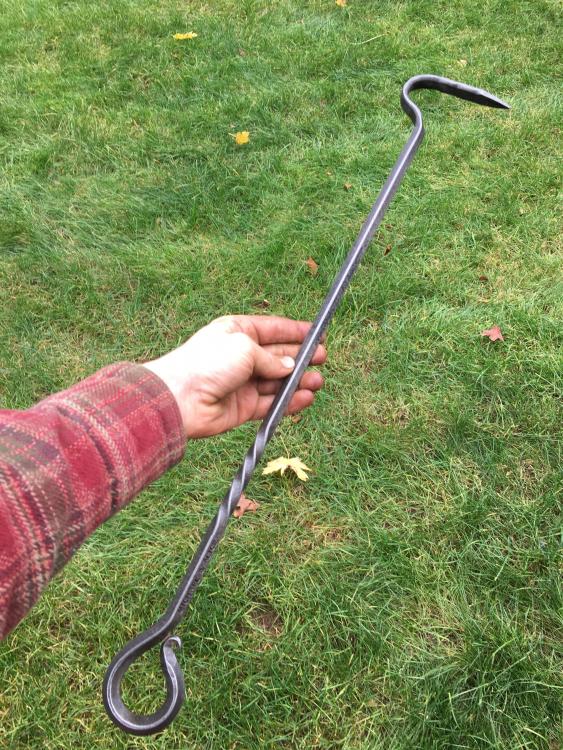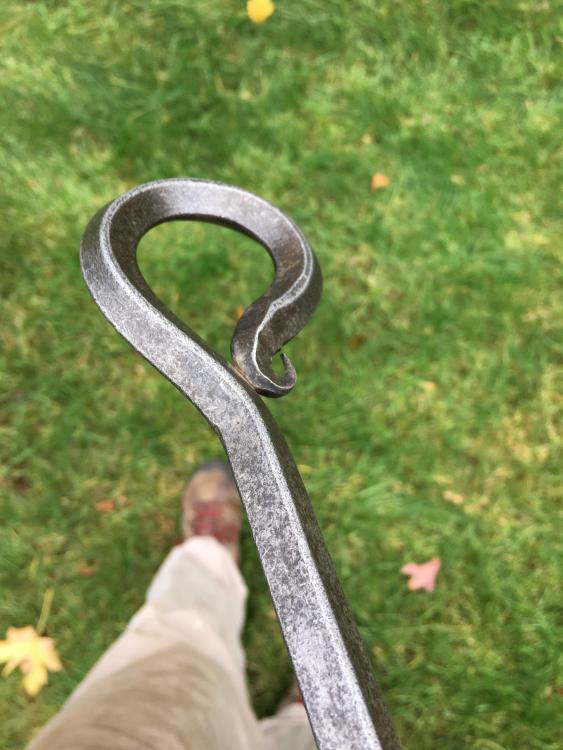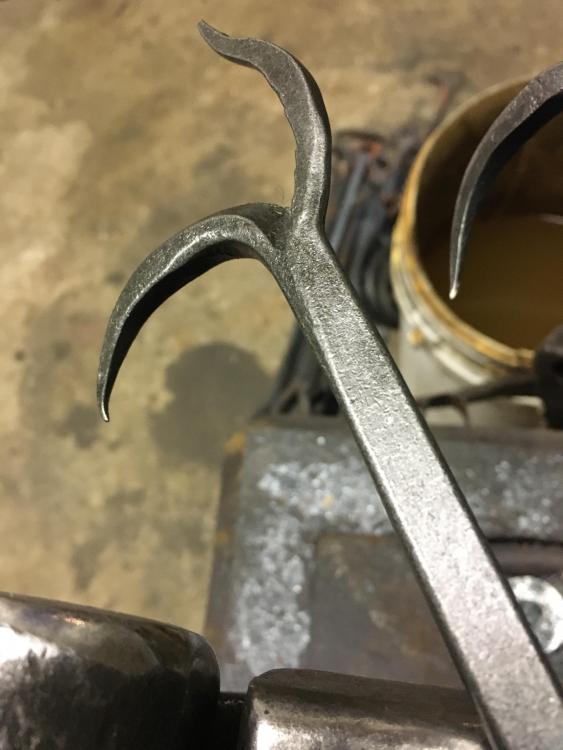
MRB
-
Posts
32 -
Joined
-
Last visited
Content Type
Profiles
Forums
Articles
Gallery
Downloads
Events
Posts posted by MRB
-
-
I've seen someone press skillet pans cold with a 20 ton fly press, so I was curious if using one of those bottle jack h frame presses would work the same? Of course its wouldn't be a permanent solution, but you think it would work? What are the advantages of a fly press compared to one of those hand cranked presses, given they are the same tonnage?
Thanks
-
Given a 20 ton fly press can form these pans, I'm curious if one of those 20 ton H frame shop presses would work for this. I have my coal iron press for forging, so I wonder if getting one of these cheap hand cranked presses would work for forming the pan blanks
-
Simple, I like it! Obviously thats a pretty wide set of dies, what kind of press are you using? I'm thinking I'll need a large throated c frame press, almost the shape of a fly press, in order to fit the discs in
-
On 8/1/2021 at 10:03 AM, Adriaan Gerber said:
I've hot pressed a 10" skillet in my 20 ton press in one go. A bearing race on the bottom with a round chunk of steel on top with some clearance. Finish with the hammer.
If you could give some more info on what press you have and those dies, that would be awesome!
Thanks
-
Here are those videos, one he uses his press and the other he uses the fly press. Maybe this will give a better idea of what I'm envisioning. He does some really nice looking work
Skip to 3:40
Skip to 1:15
-
My press isn't currently wide enough to allow pressing a skillet to begin with, so I'll need to build or buy a new one anyways. I'm just curious if 25-30 tons will be sufficient before I make the investment. I will try making probably 13" frying pans max, out of 12 gauge mild, maybe a 2" lip on them. So basically want to press a 15" round piece of 12 gauge into a rough pan shape, ready for hammer dressing. I could heat the discs if absolutely necessary if I make a new forge, but I have seen it done cold and was curious if anyone else has seen it done.
Ive also considered metal spinning, however a lathe will take up more space then my already useful forge press I need for everyday production. But, I have heard of guys spinning with standard wood lathes, so I guess it might be an option
-
Pardon my previous wording, I meant to say he pressed in one motion, not heat. He did it cold
-
Thanks for the reply. I did see a guy using what he claimed to be a 25 ton press, stamp large cook skillets in one heat. Even saw him use is 25 pound fly press. Of course there was hammer clean up needed, but I wish there were more details as to how he was able to do this cold
-
Hi,
I would like to expand my current production of cookware, and start offering skillets and frying pans. Forging them by hand takes too much time to be profitable, so I was curious if I could press them cold with a press? I currently have a coal iron 12 ton, but I doubt the 12 tons will suffice. Do you think a 25 ton press would work with a proper forming die? Could I get away with one of those hand cranked presses too to dish them out cold? Thanks
-
Hi All,
Looking to expand from making fireplace tools by now venturing into mantles and getting into screens/doors. Not sure now is the best time since winter is almost over, but then again, maybe people rather do the work while the weather is warm and they don’t have a fore going. Anyways, where do you all get your screen material from? Where I looked online, it seemed quieter expensive. Wasn’t sure if even regular door/window screen would work?
Thanks
-
Do you blast before painting? I've been making a bunch of fire pokers and have been painting them with rustoleum hammered spray paint. Knock off the loose scale quickly with a wire brush, then applied directly over. Been very durable and looks great, but I'm not sure it would be good enough for an outdoor railing.
-
I appreciate all the replies! Will definitely look into everything recommended!
Thats some nice work! How did you finish all those railing? Blast and powder coat? And when you say you find the salary higher with less effort, are you referring to doing furniture/flower supports compared to fences and gates. Or were you referring to architectural smithing as a whole compared to the little nick knack stuff.
Thanks!
-
I was curious how those of you that do larger ornamental work, like railings, tables or fences, got your first commission? I assume as you progress and build a portfolio of previous projects, customers are more inclined to commission you. I would love to slowly venture into doing some larger projects like railings or tables, but am trying to figure the best way to get my feet wet in the process. I currently hammer full time, but only do smaller items that are bought and shipped online. The largest ornamental type pieces I have done are fireplace sets. Any advice?
Thanks!
-
Anyone ever figure a way to rig up letter/number stamps on a hydraulic press? Currently I personalize items with the steel at a red color, but I believe I can be way more efficient if I can do it while the metal is cold. However, when cold, the stamps aren’t hammered in as easily. I have a coal iron 12 ton press, and I am trying to figure a way if maybe I can rig up a quick change stamp setup to allow for efficient stamping. The only issue is trying to come up with a stop type of fixture, as if you aren’t careful, you can push the stamp halfway through the material and ruin the piece. Any recommendations or previous setups? Maybe a 1 ton bottle jack would be enough to stamp without over doing it?
Thanks
-
Hi,
Just a quick question regarding ceramic blanket/board fibers. Everyone seems to emphasize sealing their forges to prevent loose fibers from drifting in the shop. However, when I look at forges such as Diamondback, it seems as if they just use raw ceramic blanket with nothing over it. I’ve also been told by another smith who I highly respect that there is no need to seal the fibers, as unless you poke or scrape at the blanket, fibers won’t come loose. Seeing his forge operate, I understand this point. Also, MSDS for Inswool/Kaowool never really states a carcinogenic hazard either, listing it more as a potential irritant. I understand that I don’t want to breath in anything extra I don’t have to, but is there really a significant hazard to the unlined ceramic blanket, and does anyone use a Diamondback or similiar forge with the raw wool?
-
Interesting. That’s another good point. I forgot there is the naturally aspirated (narb) ribbon burner, as well as the blown version (barb). I was referring to the blown version, but I wonder how the narb vs blown version compare to each other. My current forge is so efficient, I didn’t think I would be able to find something even more efficient. Before spending a few hundred on a blow assembly, I wanted to make sure I would see a notable difference
-
The hype today seems to be about the ribbon burner. People claim to have run these at 1/2 psi of propane for a small forge, and essential craftsman on YouTube says he runs his gigantic gas forge at 5 psi for regular forging. Compared to a Venturi burner, however, how relevant is this info?
I have a Venturi style burner made by someone named Steve Geisheimer, and it’s awesome! Very efficient, I run my Freon tank forge at around 3 psi for production forging. I’m looking at building a slightly larger forge, and am considering the ribbon burner if it will save me fuel and be more efficient at heating.
When comparing both styles, figure in the same exact forge, is 3 psi through the small orfice of a Venturi style burner the same consumption as 3 psi through 15 or so 5/16” holes in a ribbon burner? I feel like since the ribbon burner has more individual orfices, it has to burn more fuel at any given pressure then a Venturi would.
Any experiences or recommendations as which burner to use for my next forge?
-
I might as well create a sticky with all the finishes I have tried in the last year or so! My recent kick has now been hammered paint for my production pokers, as it is looks decent and requires minimal prep. Keep in mind that I am making close to 20 pokers a day, and spending the time to completely wire wheel all forge scale, then individually heat each poker to apply a wax or oil is not very feasible. The one thing I am not 100% satisfied with is how the Rustoleum hammered paint is very glossy. The conventional black hammered paint from them looks good, but like I said, too shiny. The matte version is more silver in color, which still looks nice, but has some sparkly stuff added in it that I am not a fan of. Are there any other paints/finishes that you guys have used that look more natural to a forged look, but more matte in appearance?
Thanks
-
I’m glad I asked, everyone has some real good ideas! I experimented with the hammered paint today, and I like it. It won’t replace a nice clean wax finish, but for my large production items like pokers, the paint will work great. Plus I can put that stuff right over the scale. I painted a poker, and did a nice abuse test bringing the poker tip to a yellow heat in my forge. The paint burned up on the working end of course, further down wasn’t terribly effected and wore in nicely with the shaft of the poker. Plus I can offer different colors if desired too, and this should last better to rust if stored outdoors for pits then my normal linseed oil finish
-
Great call with the paint fellas! When I research Hammertone, two options come up. Either Hammerlite or Rustoleum Hammered Paint. Are both similar? And how would they wear to the heat of a fire at the tip?
Thanks
-
Hi,
I have been experimenting a lot lately, and am trying to find a clean and efficient finish for my fire place sets. Wire wheeling takes a while and is dangerous, sandblaster takes a while and doesn’t look nice, tumbler worked great but now doesn’t function. I’m just interested to know what most other professional smiths do to clean up their work before applying linseed oil or other finishes.
Thanks!
-
Thanks for all the replies everyone! Wrapped the tumbler in an old yoga mat today, reducing noise and adding more traction! I will now not be up until 10 cleaning and packaging pokers! Or maybe I will be, but will be getting more done!
-
Awesome news! I threw in a bunch of nails and scrap metal, and tumbled a dozen pokers and half a dozen matching hooks today. They were in for about an hour and a half, and came out looking really nice! They weren’t the scaleless shiny look I normally get with the wire wheel, but it’s a real clean stonewashed looking finish which I really dig. I wiped each one down with a rag soaked in linseed oil, and I’m gonna stick with this method over the sandblaster. I put the tumbler in the shed, and that helped dampen some noise. I’m also gonna pickup some bedliner at harbor freight, and some felt or carpet to wrap the drum with. Really can’t be happier, this is gonna save a lot of time, and for the price four casters, well worth the investment!
And what’s the deal with throwing in linseed oil while the parts are tumbling? Will this actually work, or will all the dust and scraping parts interfere with a good finish? And what would be the best way to do this? Soak a rag and throw it in, or dump some oil directly in?
-
Hello Again,
So as some of you know, I recently built a tumbler which works pretty well, unfortunately it’s very loud. I’m considering ways to dampen the noise, but until then, I’m considering picking up a sandblaster since suburban NJ isn’t craving the current setup! I am finishing mostly 24” Fire pokers, with matching hooks to go with them. I understand that sandblasting often gives a duller finish with the standard aluminum oxide media, and I would like something a little more polished then that. Anyone use that black diamond coal slag or steel shot? I’m curious how well they can clean mill scale, and the finish they leave behind. I spray with a krylon clear coat, so that helps to add a little bit of shine and color to what is already on the poker. I was thinking of running to Harbor Freight or Tractor Supply this weekend to pick up a cheap one, but I’m not sure how capable those machines are at other media’s like shot or slag. Thank you!



Champion #1 Power Hammer
in Power Hammers, Treadle Hammers, Olivers
Posted
Hey Fellas!
I’m a full time smith now, and have been moving more towards the knife world and would really love to pick up a power hammer for beveling and profiling. My steel supplier has a 25 pound LG he’s willing to sell to me, but I also happened to stumble across a #1 Champion Hammer. How do the Champion hammers compare to LG? I assume it’s harder to find parts for the Champion, but is it a better hammer? Funny how when you’re not looking for something you stumble across em! Just like trying to find your first anvil.
thanks in advance